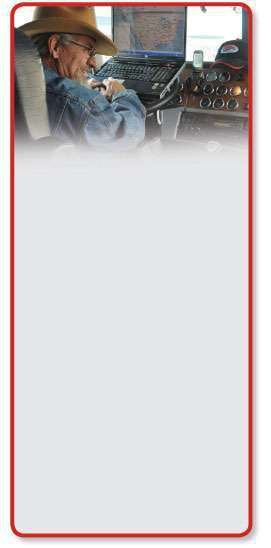The extra profit of a small fleet comes with the high price of investment, planning and stress.
With freight demand increasing and rates improving, it could be an opportune time to add another truck to your operation. For a one-truck operator, though, that’s a huge step, no matter how buoyant the economy. Adding equipment requires detailed planning, substantial financial resources, more time devoted to management and, consequently, more headaches.

Finding and keeping dependable drivers represents a big hurdle to expansion for Jerry Kissinger of Independent Operator. Behind him is the “Freedom”-themed trailer pulled by his 1991 Mack Superliner show truck.
An owner-operator with solid relationships with a broker, shipper or consignee who has consistent loads may be able to tap into improving freight to keep an added truck moving. But “you have to remember that could dry up in a matter of months,” says David Wolff, a consultant with financial services provider ATBS. “You have to have a backup plan. You don’t want to put all your eggs in one basket.”
Managing a second truck requires daily attention, no matter how experienced and efficient its driver. It is your responsibility to keep both trucks busy and running legally and to arrange for maintenance and repairs. Even in the smoothest of situations, these added responsibilities cut into your time on the road and at home.
In most cases, another driver isn’t going to take care of your truck or drive it as efficiently as you do. You will have to monitor the truck’s condition to make sure it will make you money. A breakdown of one truck could affect the other truck because arranging for repairs will require your attention.
It often takes two years to break even when adding a second truck, Wolff says. The odds of making money improve when you add third and fourth trucks.
Before making any move, calculate expenses, such as truck payments, licensing, taxes, fees, driver pay, insurance, fuel costs and maintenance and repairs, recommends Tim Brady, a small fleet consultant. Some operators have found it necessary to finance a second truck’s startup expenses with credit cards or small loans until the extra income is flowing steadily, he says. Added debt is always risky for an owner-operator, so it’s preferable to have enough money saved to sustain yourself during startup or later slow periods.
There are two common ways to structure a multi-truck operation. You can get your own operating authority and run a second truck under it. Or you can lease your trucks to a carrier, operating under the carrier’s authority.
Under your own authority, you have to find loads for all your trucks, and you’ll face additional administrative and regulatory responsibilities. “You might as well consider yourself a carrier because you’re going to have all the same reporting, safety and CSA (Compliance, Safety, Accountability) problems that the major carriers have,” Wolff says.
Leasing trucks to a bigger carrier will allow you to hand off some of the paperwork and regulatory tasks. Plus, you’ll enjoy the security of available load choices, though the earning potential isn’t as great.
Under either option, you’ll have to hire a driver. That means added obligations for state and federal taxes, worker’s compensation insurance and drug testing, among others. Are you ready to motivate that person? Do you have time and know-how to handle the paperwork? Or will you need a family member or hired help to take care of it?
You’ll also have to stay current with the driver’s logs and safety record. Violations by your drivers will reflect on your CSA score as a carrier.
As Bruce Barton, owner-operator of the Idaho Roads small fleet, says: “It never stops.”
Best practices: Real world examples
Advice from four owner-operators who’ve dealt with expanding:
LINE UP FINANCING. Take a conservative financial approach to expansion, says Doug Bench, owner of Blackfoot, Idaho-based Crossline Transportation. He advises having funds to cover at least two months’ operating capital for fuel, maintenance, insurance, licensing and driver wages. To add one truck and driver in a long-haul application, those expenses could easily total up to $18,000 for two months.
“You should get a line of credit at a bank or find a good factoring company, because you’re going to need that cash flow to operate,” he says.
Bench says he used to depend only on his own cash flow, but now he works with a factoring company on part of his receivables. He also works closely with an accountant, who has helped plan depreciation schedules for his trucks.
FIND MULTIPLE CUSTOMERS. Owner-operator Bruce Barton says he learned the hard way not to devote too much business to one account. When the economy tumbled and the housing market collapsed, Barton’s Idaho Roads lost a construction materials contract that had been keeping the five-truck fleet afloat. “We had to reinvent the company and what we were hauling,” he says.
Barton says of about 50 customers, he has about a dozen steady ones. “We’re not making a profit now,” he says. “We’re still digging our way out of the hole [from] when the economy crashed.”
HIRE RELIABLE DRIVERS. Jerry Kissinger has managed trucks and drivers in his Madison, Wis.-based Independent Operator fleet for many years. Finding reliable drivers who will stick with you is paramount, says Kissinger, whose fleet owns seven tractors and 19 trailers.
Not only is it hard to recruit drivers, but it’s expensive when they turn over quickly. “If you put a guy in a truck and he lasts only two weeks or so, it still costs us $3,000 to get him legal and pay for drug testing.”
DISPATCH YOURSELF. Marty Keim, president of Dodge City Express in Kansas, says expansion requires knowing what each truck is doing, and he recommends arranging to take the dispatch yourself, even when leasing to a carrier.
If you self-dispatch, you can keep tabs on your trucks’ whereabouts, availability and deadhead miles. Also, leasing to a carrier can help you handle administrative duties, Keim says. “If you lease on there’s more security and you take on the business you can handle. Carriers take on some of administrative tasks of your trucks that you don’t have to worry about.”
Two cautionary tales
Tilden Curl tried working a second tractor and trailer for about two years. He paid the driver 30 percent of the truck’s gross. After the driver left, Curl sold the truck and trailer to a driver who leased to him. That driver ran under Curl’s authority for three years, until the equipment was paid off.
Now Curl runs I-5 from Olympia, Wash., to Southern California solo. He hauls lumber and other loads south and hot tubs and an occasional load of steel north.
“I had experience with direct employees and a leased operator,” he says. “Frankly, there’s not enough money in it to make a profit that’s worth the liability you put out there.”
Curl calculates a minimum 10 hours of administrative time per truck per week, a cost of at least $50 an hour if you paid someone to do it for you.
“For me to make another $1,000 to $1,500 a week by putting another truck on to give me compensation for my risk, I don’t see that happening,” he says. “I can barely pay myself.”
With his 2009 Kenworth T660, he grosses $200,000 to $250,000 a year, running roughly 100,000 miles. He pays himself $2,000 a month. His wife draws a salary, too, for keeping the books, billing and dealing with brokers.
Azmi Azad thought he could make money hiring a friend to drive his truck. He hired her in November and paid cash for another truck that he drove.
But the friend peppered Azad with questions about directions and complaints about loads. “She was trying to make as much money as quick as she could,” says Azad, who’s been driving since 1990 and has been leased on to Schneider National Inc. for 18 months.
“A second truck is too much, mentally and financially. I was exhausted at the end of the day. I had no time to think about anything.” After three months, he sold the truck she was driving.
Azad says he had been taking home $2,000 a week from the truck. But while his friend was driving for him, he was losing $500 to $600 a week. “I lost $10,000 in that deal,” he says.
What did he learn? “You want to make money, you work it yourself,” he says.
He recalled a warning from David Wolff, an adviser at financial services provider ATBS. “He said if you want to make money, you have to have at least five trucks. Some people can run five trucks, but I don’t know how.”
SURVIVING THE RECESSION
After driving for more than 18 years and working in operations management for different fleets, Bruce Barton decided in 2001 to work for himself. He bought a used truck and found loads by tapping into his industry contacts.

When the economy crashed, Bruce Barton of Idaho Roads had to find new freight and routes to keep his trucks running.
By 2007 he owned five trucks, operating his Idaho Roads fleet from his New Plymouth, Idaho, base. Clients asked for more capacity.
“It was pretty easy to say yes to more trucks. The economy was going good. I didn’t want to lease on to someone. To buy a truck and lease on to someone and expect to make a living — it’s foolish.”
Barton had a contract to haul three to five loads a week with multiple stops in Utah and Colorado. A couple of trucks had regular back hauls. “A piece of cake,” he says. “Drivers knew when they had to be back to pick up the next load. I was making good money.”
The collapse of the housing market reduced that contract to a load a week. Barton’s wife quit her job and joined his company, which he says saved his business. “She keeps dialing the phone looking for freight,” he says. “There are times my spirit gets trampled. She keeps hammering. There’s only so much you can do from the steering wheel of a truck.”
Barton and his wife picked up feed and manufacturing accounts in Iowa, Minnesota and Wisconsin, which represent 70 percent of his $850,000 in annual revenue. “We have a really excellent freight base right now,” says Barton, who expects to stay at five tractors. “We have loads available to us we can’t get to quick enough because we’re so small. We have to say no sometimes.”
Barton says when he factors in fuel costs, driver wages, insurance and taxes, total costs add to $1.20-$1.30 a mile. He’s getting $2 a mile minimum.
EXPANSION HEADACHES
Jerry Kissinger likens adding a truck to gambling. “How do you make a little money? You start with a lot of money,” he says. “You’re rolling the bones.”
When Kissinger began running the family trucking business in the early 1990s, the company owned eight trucks and had more than 30 leased owner-operators . Kissinger’s Independent Operator, based in the Madison, Wis., area, now owns seven trucks and has six owner-operators. He’s had both company drivers and owner-operators bail out.
“If I had 20 trucks [with drivers] I could trust tomorrow, I could keep them loaded,” he says. “Our biggest problem is drivers start out gung ho but then start asking for time off for this and that. It’s hard for a small company with a few customers.”
Kissinger checks backgrounds and references but bases hiring decisions mostly on instincts. “I say, give it three months, because we’re not your average company. We’re a family operation and we like to run hard,” he says.
“I had a driver who had to take off for awhile, and he came back to me. I put him in a truck but had issues with the truck, so I went out and bought a brand new [Kenworth] T660. I feel that confident with him. With me, I’ve got to go with my gut.”
If Kissinger finds a driver he wants to hire, he says he can quickly locate a tractor. He says he’s considering a truck lease with an option to buy that includes maintenance. “That’s probably a pretty good thing when you want to try a driver without the expense of getting stuck with another payment,” he says.
A small working model
In 2001 Doug Bench bought a truck from an Idaho Falls company where he had been a driver, and began to earn 80 percent of each load. After a year, he used $18,000 he had saved to cover a truck down payment and repairs and hired a friend to drive for him.
After Bench’s carrier changed the lease terms, he left in 2005 and opted to run under his own authority as Crossline Transportation. The fleet hauls potatoes to Cleveland, Detroit and Indianapolis.
Within a year, another owner-operator signed under Bench’s authority. “We have a successful working model, and if they come in and run under that model, they’ll make money as we have done,” Bench says.
Under Crossline’s model, drivers run on a six-day turnaround from Idaho to the Midwest. Each round trip is at least 3,400 miles, and drivers average about three round trips per month. Eastbound rates range from $1.80 to $2.20 a mile.
Of the four trucks Bench owns, two are leased to owner-operators and two are driven by company drivers, and each grosses about $250,000 a year. He has seven other contractors leased under his authority.
Bench wants to expand to a fleet with five company drivers. “I don’t want any more than that to manage,” he says.
His other company, DJ Truck Leasing, also signs owner-operators to lease or provide their own truck if it meets certain specs. “We dispach owner-operators and charge 10 percent of revenue,” Bench says. “Of that, 5 percent goes to a non-recourse factoring company, and owner-operators are paid within 14 days.”
Drivers can run with their own authority, too, and for $55 a load Bench will dispatch and handle invoicing. He also charges $125 a month for an electronic onboard recorder service, which he requires in all trucks running for him.










